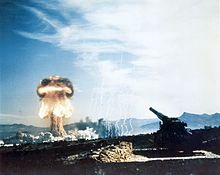"Atomic Annie" redirects here. For the French businesswoman and nuclear power advocate, see
Anne Lauvergeon.
The M65 atomic cannon, often called "Atomic Annie",[3] was an artillery piece built by the United States and capable of firing a nuclear device. It was developed in the early 1950s, at the beginning of the Cold War, and fielded, by 1953, in Europe and South Korea.
History
Upshot–Knothole Grable test (film)
Picatinny Arsenal was tasked to create a nuclear capable artillery piece in 1949. Robert Schwartz, the engineer who created the preliminary designs, essentially scaled up the 240 mm shell (then the maximum in the arsenal) and used the German K5 railroad gun as a point of departure for the carriage.[2] (The name "Atomic Annie" likely derives from the nickname "Anzio Annie" given to a pair of German K5 guns which were employed against the American landings in Italy.[1]) The design was approved by the Pentagon, largely through the intervention of Samuel Feltman,[2] chief of the ballistics section of the ordnance department's research and development division. A three-year developmental effort followed. The project proceeded quickly enough to produce a demonstration model to participate in Dwight D. Eisenhower's inaugural parade in January 1953.
The cannon was transported by two specially designed tractors in the same manner as railroad Schnabel cars. Both tractors were capable of independent steering in the manner of some extra-long fire trucks. Each of the tractors was rated at 375 horsepower (280 kW), and the somewhat awkward combination could achieve speeds of 35 miles per hour (56 km/h) and negotiate right angle turns on 28-foot (8.5 m) wide, paved or packed roads.[1] The artillery piece could be unlimbered in 12 minutes, then returned to traveling configuration in another 15 minutes[4]. The gun was deployed by lowering it from the tractors onto levelled ground. The whole gun assembly was balanced on a ball and socket joint so that it could be swung around the footplate. The traverse was limited by a curved track placed under the rear of the gun.[5]
On May 25, 1953 at 8:30 a.m., the atomic cannon was tested at the Nevada Test Site (specifically Frenchman Flat) as part of the Upshot–Knothole series of nuclear tests. The test—codenamed "Grable"—was attended by the Chairman-delegate of the Joint Chiefs of Staff, Admiral Arthur W. Radford and United States Secretary of Defense Charles Erwin Wilson; it resulted in the successful detonation of a 15 kiloton shell (W9 warhead) at a range of 7 miles (11 km). This was the first and only nuclear shell to be fired from a cannon.[1] (The Little Feller 1 test shot of a W54 used a Davy Crockett weapon system, which was a recoilless smooth-bore gun firing the warhead mounted on the end of a spigot inserted in the barrel of the weapon.)
After the successful test, at least 20 cannons were manufactured at Watervliet and Watertown Arsenals, at a cost of $800,000 each.[1] They were deployed overseas to Europe and Korea, frequently shifted around to avoid being detected and targeted by opposing forces. Due to the size of the apparatus, their limited range, the development of nuclear shells compatible with existing artillery pieces (the W48 for the 155 mm and the W33 for the 203 mm), and the development of rocket- and missile-based nuclear artillery (such as the Little John and Honest John tactical nuclear missiles), the M65 was effectively obsolete soon after it was deployed. However, it remained a prestige weapon and was not retired until 1963.
Surviving units
Of the twenty M65s produced, at least seven survive on display. Most no longer have their "prime movers".
- U.S. Army Artillery Museum, Fort Sill, Oklahoma (This is the original "Atomic Annie" that fired the live nuclear shot. It was restored in 2010[6] and is now displayed with prime movers replacing those that were lost in an accident when the cannon was retrieved from Germany by the museum in 1964.[7])
- United States Army Ordnance Museum, Aberdeen, Maryland (still has the two large prime movers attached)
- National Museum of Nuclear Science & History, Albuquerque, New Mexico (has two prime movers)
- Freedom Park, Junction City, Kansas, overlooking Fort Riley
- Rock Island Arsenal, Memorial Field, Rock Island, Illinois
- Watervliet Arsenal Museum, Watervliet Arsenal, Watervliet, New York, where they were all manufactured
- Yuma Proving Ground, Yuma, Arizona
The Virginia War Museum in Newport News, Virginia has been erroneously identified as possessing a 240mm prototype of the M65. The weapon at the Museum is actually a conventional 240mm T1 Gun, one of two produced as part of a separate design program which was abandoned in favor of the T131 280mm Atomic Cannon program. Both the T1 and T131/M65 share T72 carriages.[8][9]
-
1958 deployment in Korea (film)
-
Another view of the M65 at the Aberdeen Proving Ground
-
View from the front prime mover
See also
References
External links
from Hacker News https://ift.tt/2Y3HXfy

No comments:
Post a Comment
Note: Only a member of this blog may post a comment.